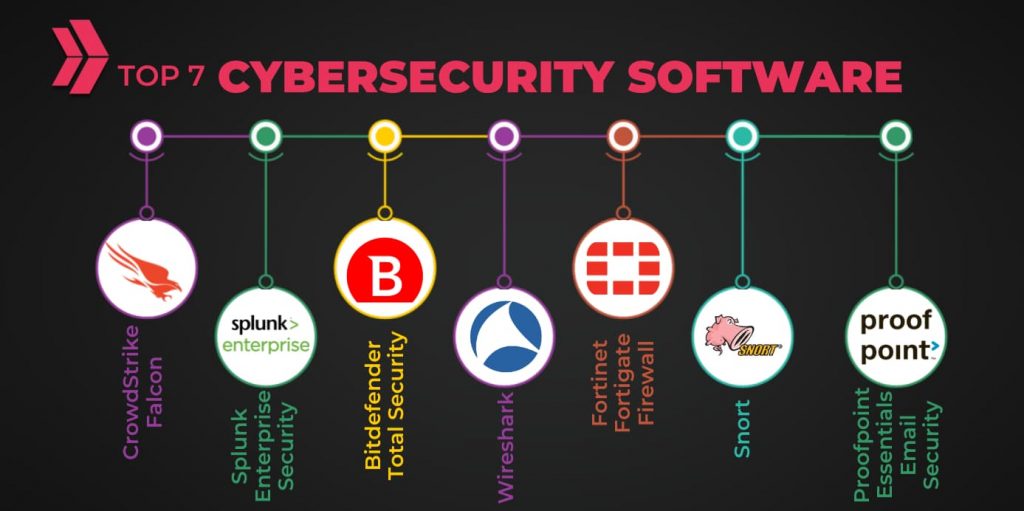Top-rated Cybersecurity Software For Businesses
Ever thought about how much data is created every day? It might surprise you to know that 2.5 quintillion bytes of data are produced daily. As businesses increasingly rely on this data, securing it becomes paramount, making the choice of cybersecurity software crucial.
Top-rated cybersecurity software today combines cutting-edge technology with user-friendly interfaces. A notable trend is the integration of artificial intelligence, which has proven to enhance threat detection accuracy by over 95%. Businesses are also prioritizing solutions that offer real-time threat alerts, ensuring immediate responses to potential breaches and enhancing overall network security.

Top-rated cybersecurity software for businesses
Top-rated cybersecurity software is essential for protecting sensitive information. Businesses have a plethora of options available. They focus on detecting and preventing threats effectively. The software often comes with features like real-time monitoring and malware detection. This ensures that breaches can be managed promptly.
Among the critical features to look for, data encryption stands out. It helps in securing business data from unauthorized access. Another important feature is firewall protection. It acts as a barrier against malicious attacks. These layers enhance a business’s defense mechanisms.
Integration with other security tools is also vital. For example, combining antivirus with antimalware provides comprehensive coverage. User-friendly interfaces make it easier for employees to navigate the software. This encourages regular use and efficient management of security protocols. A streamlined interface can significantly improve a company’s overall security posture.
Regular updates are crucial in cybersecurity software. They ensure that the system can handle new threats as they emerge. Many companies offer automatic updates to keep their software current. A proactive approach to updates can prevent potential exploits. Keeping the system up-to-date is a fundamental aspect of maintaining robust cybersecurity.
Features to look for in top-rated cybersecurity software
When selecting top-rated cybersecurity software, there are key features to consider. Real-time threat detection is paramount. This feature allows the software to identify and address security issues immediately. This minimizes damage from potential breaches. By detecting threats in real-time, it helps maintain data integrity.
Ease of use is another important feature. Employees need to navigate the software without much difficulty. A user-friendly interface enhances productivity and ensures compliance with security protocols. Look for software that offers intuitive dashboards and straightforward controls. This makes the daily operation smoother.
Automated updates are also crucial. Cyber threats evolve rapidly, and your security software should too. Automated updates ensure that the software is always prepared for the latest threats. This reduces the risk of vulnerabilities. It’s a proactive way to stay protected.
Lastly, consider the integration capabilities of the software. It should work well with other tools you already use. This might include antivirus programs, firewalls, and network monitoring tools. Effective integration helps create a holistic security system. This ensures comprehensive protection for your business.
The role of artificial intelligence in cybersecurity software
Artificial intelligence (AI) is transforming cybersecurity software, making defense systems smarter and more efficient. AI can learn from vast data sets, allowing it to identify patterns associated with threats. A huge advantage is its ability to detect anomalies, catching unusual behavior that humans might miss. AI’s predictive capabilities enable it to foresee potential threats before they happen. This proactive approach is essential for maintaining robust security.
Another benefit of AI in cybersecurity is automation. AI can handle repetitive and time-consuming tasks quickly. This means security personnel can focus on more complex issues. Automated threat detection powered by AI significantly reduces response times. This quick action is crucial in mitigating damage during an attack.
Additionally, AI improves the accuracy of threat detection. It reduces false positives, which are alarms that turn out to be nothing. This allows teams to concentrate on real threats, increasing overall efficiency. AI models continue to learn and improve over time. This constant evolution helps keep businesses safe as new threats emerge.
AI is a powerful ally in the fight against cyber threats. It works alongside traditional methods to improve security measures. As AI technology advances, its role will become even more integral. Businesses adopting AI-driven cybersecurity solutions gain a significant edge. This ensures both resilience against attacks and peace of mind in safeguarding their data.
Importance of real-time threat alerts
Real-time threat alerts play a critical role in safeguarding digital assets. They ensure that threats are identified and addressed immediately. Cyber threats can cause significant harm if not dealt with promptly. The ability to respond quickly helps minimize damage. This is especially crucial for businesses that handle sensitive information.
The quicker a threat is detected, the faster it can be neutralized. Real-time alerts provide instant notifications of any suspicious activities. These alerts empower security teams to take swift action. Such prompt responses are vital for protecting data. They also help in maintaining customer trust.
With real-time alerts, businesses can stay ahead of cyber criminals. Advanced alerts use AI to monitor systems constantly. This includes checking for unusual patterns or behaviors indicative of an attack. By continuously scanning the environment, these alerts prevent escalations. Prevention is always better than dealing with the aftermath of a breach.
Implementing real-time threat alerts also contributes to compliance with regulations. Many industries require businesses to demonstrate quick responses to threats. Meeting these standards is easier with automated alerts. This keeps the business in good standing legally. Compliance also builds credibility with clients and partners.
Moreover, real-time alerts reduce stress on IT teams. They automate the monitoring process, freeing up valuable time. Teams can focus more on strategic security measures. This helps in optimizing resources and improving overall security posture. It strategically positions the business to handle cyber challenges effectively.
Ensuring user-friendly interfaces in cybersecurity software
User-friendly interfaces in cybersecurity software are crucial for effective operation. A simple, intuitive design allows users to navigate the software with ease. This is important for both tech-savvy individuals and those less familiar with technology. Clear menus and straightforward options enhance user experience. This ease of use encourages regular engagement with the software.
An intuitive interface also reduces training time. Employees can quickly learn how to use the software without extensive instruction. This saves resources and boosts productivity. When users are comfortable with the interface, they are more likely to report issues promptly. This helps in maintaining the security of the system.
Moreover, user-friendly software often includes customizable features. This means users can adjust settings to meet their specific needs. Customization enhances flexibility and control. It allows businesses to tailor the software according to their unique security requirements. This adaptability is beneficial in addressing diverse cybersecurity challenges.
Incorporating visual aids can also improve user experience. Graphs and dashboards can present data in an easily digestible format. These aids simplify complex information, making it understandable at a glance. Visual elements help users quickly assess the security status. Immediate access to vital information supports proactive decision-making.
Furthermore, a good design considers accessibility. The software should be usable for people with various abilities. Features like screen readers and high-contrast modes ensure inclusivity. Accessible design makes cybersecurity efforts more comprehensive. This contributes to a culture of security within the organization.
Future of cybersecurity software for businesses
The future of cybersecurity software for businesses looks promising, with technology rapidly evolving. Artificial intelligence is set to play an even bigger role, making systems smarter and more adaptive. Machine learning will enhance threat detection capabilities. This means predicting attacks before they happen becomes more achievable. As a result, businesses can stay a step ahead in safeguarding their data.
Cloud-based solutions are also on the rise, offering flexibility and scalability. As more companies shift to remote work, cloud security becomes crucial. Modern cybersecurity software will integrate more cloud protection features. This ensures that data stored on remote servers remains secure. Businesses will appreciate the convenience and enhanced protection that cloud solutions provide.
Another aspect gaining traction is zero-trust architecture. This approach assumes that threats could potentially come from either outside or within the organization. It demands rigorous verification for every access request. Implementing zero-trust models strengthens a company’s defense mechanisms. It reduces the chances of unauthorized access to sensitive information.
Moreover, user education will play a key role in future cybersecurity strategies. Software will include more educational tools to train employees. Knowledgeable users are less likely to fall for phishing attacks and other scams. Empowering staff with the right information supports overall security. Companies investing in training see improved protection and reduced risks.
Finally, enhanced global cooperation is expected. Cyber threats are not confined to one region, so international partnerships will help tackle them. Sharing information and resources helps everyone stay safer. These collaborations will promote a unified approach to cybersecurity. Working together, businesses worldwide can face the challenges ahead.
Conclusion
In summary, the landscape of cybersecurity continues to evolve at a rapid pace, demanding businesses to stay vigilant. Implementing top-rated cybersecurity software is no longer optional but essential. Incorporating AI, real-time alerts, and user-friendly interfaces significantly boosts security.
As technology advances, future cybersecurity measures will become even more sophisticated and accessible. Businesses that prioritize training and adopt zero-trust architectures will be better equipped to face emerging threats. Ensuring robust cybersecurity now will safeguard the future of enterprises globally.
